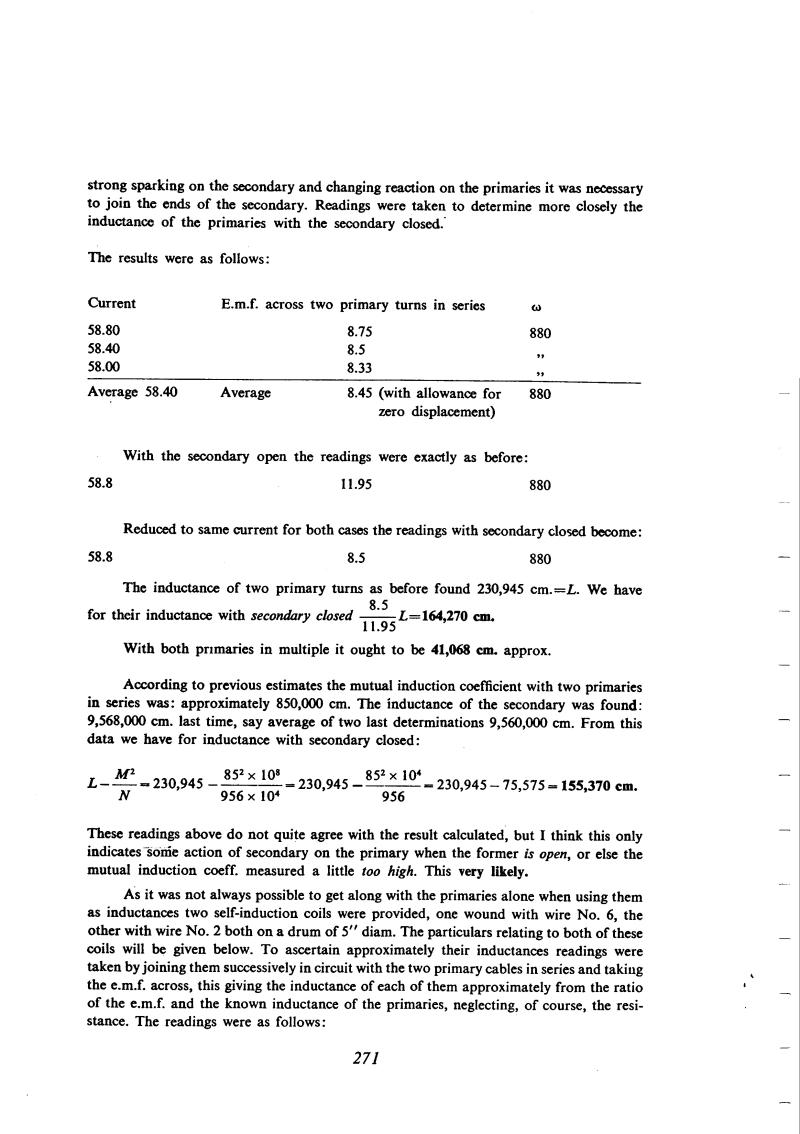
Nikola Tesla Books
strong sparking on the secondary and changing reaction on the primaries it was necessary to join the ends of the secondary. Readings were taken to determine more closely the inductance of the primaries with the secondary closed.
The results were as follows:
| Current | E.m.f. across two primary turns in series | Ï |
|---|---|---|
| 58.80 | 8.75 | 880 |
| 58.40 | 8.5 | " |
| 58.00 | 8.33 | " |
| Average 58.40 | Average 8.45 (with allowance for zero displacement) | 880 |
With the secondary open the readings were exactly as before:
| Current | E.m.f. across two primary turns in series | Ï |
|---|---|---|
| 58.8 | 11.95 | 880 |
Reduced to same current for both cases the readings with secondary closed become:
| Current | E.m.f. across two primary turns in series | Ï |
|---|---|---|
| 58.8 | 8.5 | 880 |
The inductance of two primary turns as before found 230,945 cm.=L. We have for their inductance with secondary closed $! {8.5 \over 11.95} $! L = 164,270 cm.
With both primaries in multiple it ought to be 41,068 cm. approx.
According to previous estimates the mutual induction coefficient with two primaries in series was: approximately 850,000 cm. The inductance of the secondary was found: 9,568,000 cm. last time, say average of two last determinations 9,560,000 cm. From this data we have for inductance with secondary closed:
L â $! {M^{2} \over N} $! = 230,945 â $! {{85^{2} \times 10^{8}} \over {956 \times 10^{4}}} $! = 230,945 - $! {{85^{2} \times 10^{4}} \over 956} $! = 230,945 - 75,575 = 155,370 cm.
These readings above do not quite agree with the result calculated, but I think this only indicates some action of secondary on the primary when the former is open, or else the mutual induction coeff. measured a little too high. This very likely.
As it was not always possible to get along with the primaries alone when using them as inductances two self-induction coils were provided, one wound with wire No. 6, the other with wire No. 2 both on a drum of 5" diam. The particulars relating to both of these coils will be given below. To ascertain approximately their inductances readings were taken by joining them successively in circuit with the two primary cables in series and taking the e.m.f. across, this giving the inductance of each of them approximately from the ratio of the e.m.f. and the known inductance of the primaries, neglecting, of course, the resistance. The readings were as follows:
271
November 9
He performs the interesting measurements of the mutual inductance on the basis of the primary inductance when the secondary is open, and in short circuit. He measured inductances at constant current and frequency so the calculation procedure is simplified. The obtained mutual inductance he compared with the inductance determined previously by means of induced voltage under no load conditions. Tesla thinks that the difference originates from the influence of the secondary on the primary when the secondary is open. In some cases for the purpose of oscillator operating frequency reduction Tesla used two separate coils which he did not name but designated by numbers. He compared the calculated and measured values for these coils. The measured value on the basis of voltage the ratio method amounts to approximately 2% less than values measured on the basis of voltage, current and frequency. The calculated values are smaller in both cases. The correction of measured values according to comment of Oct. 26 is not large (approximately 5%) because the ratio D/1 is relatively small.

